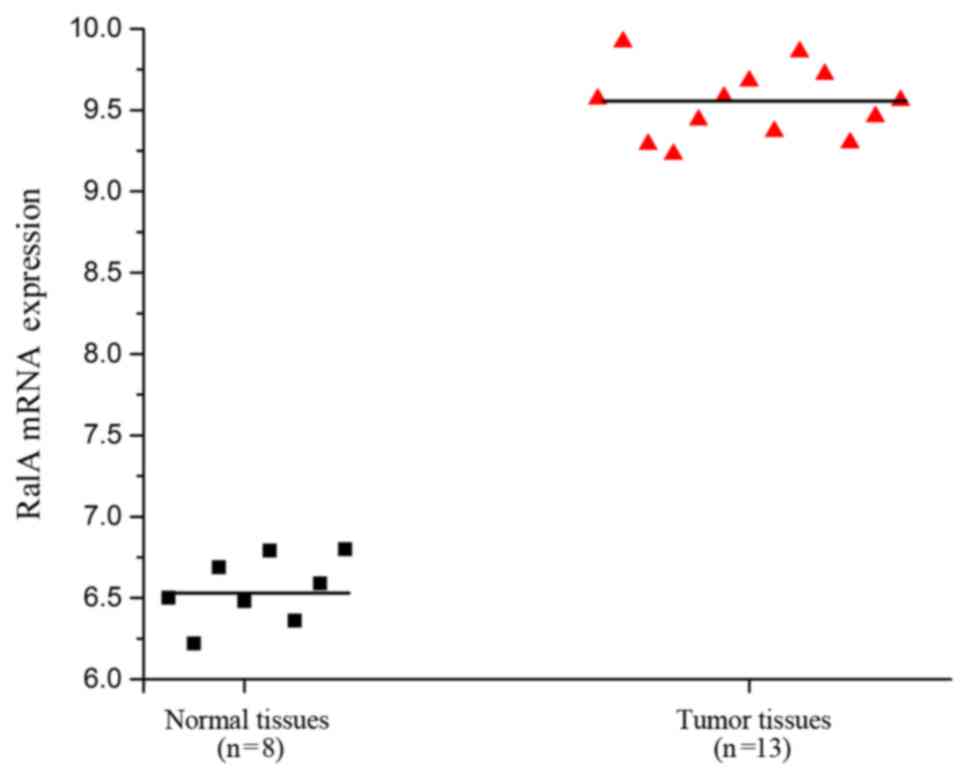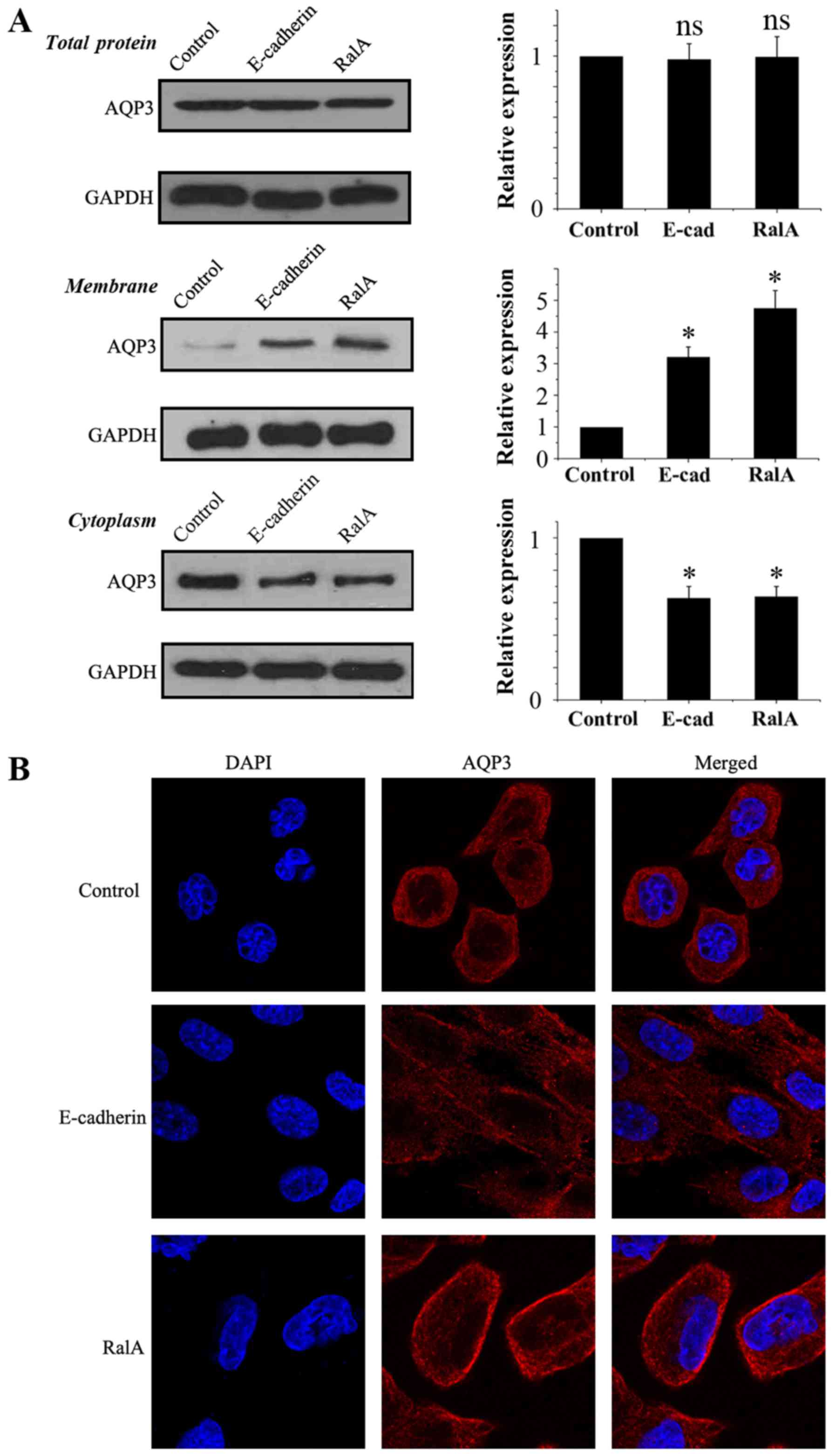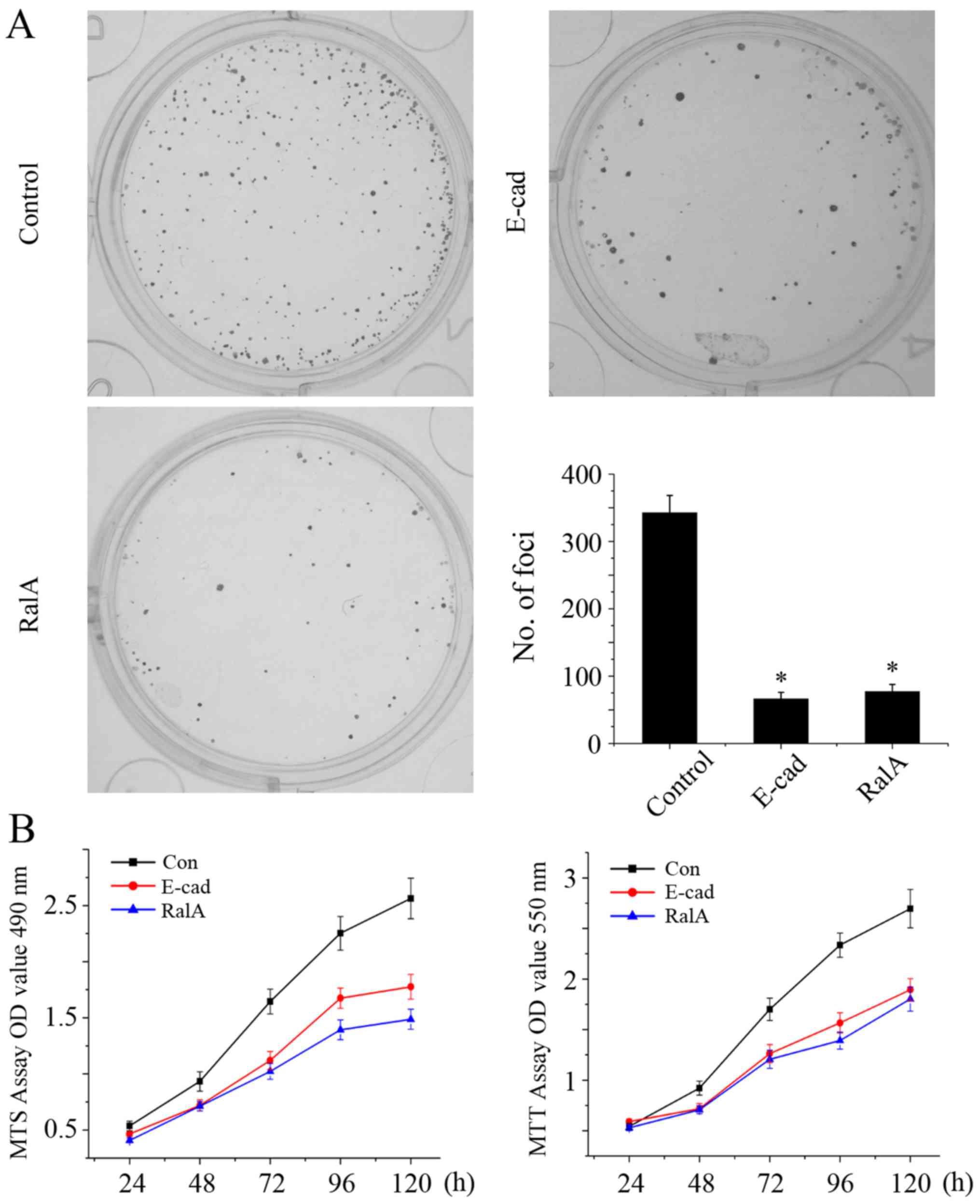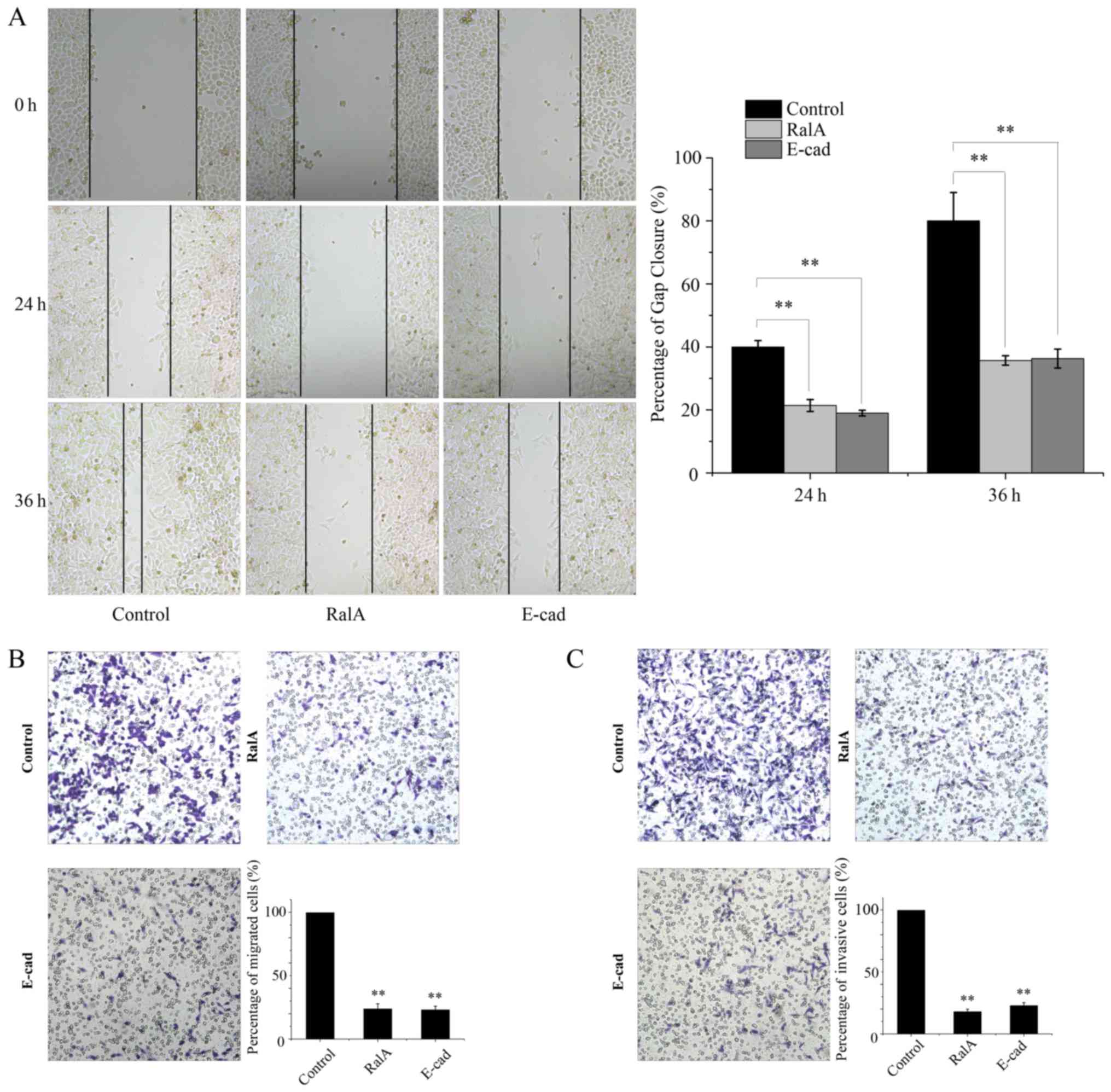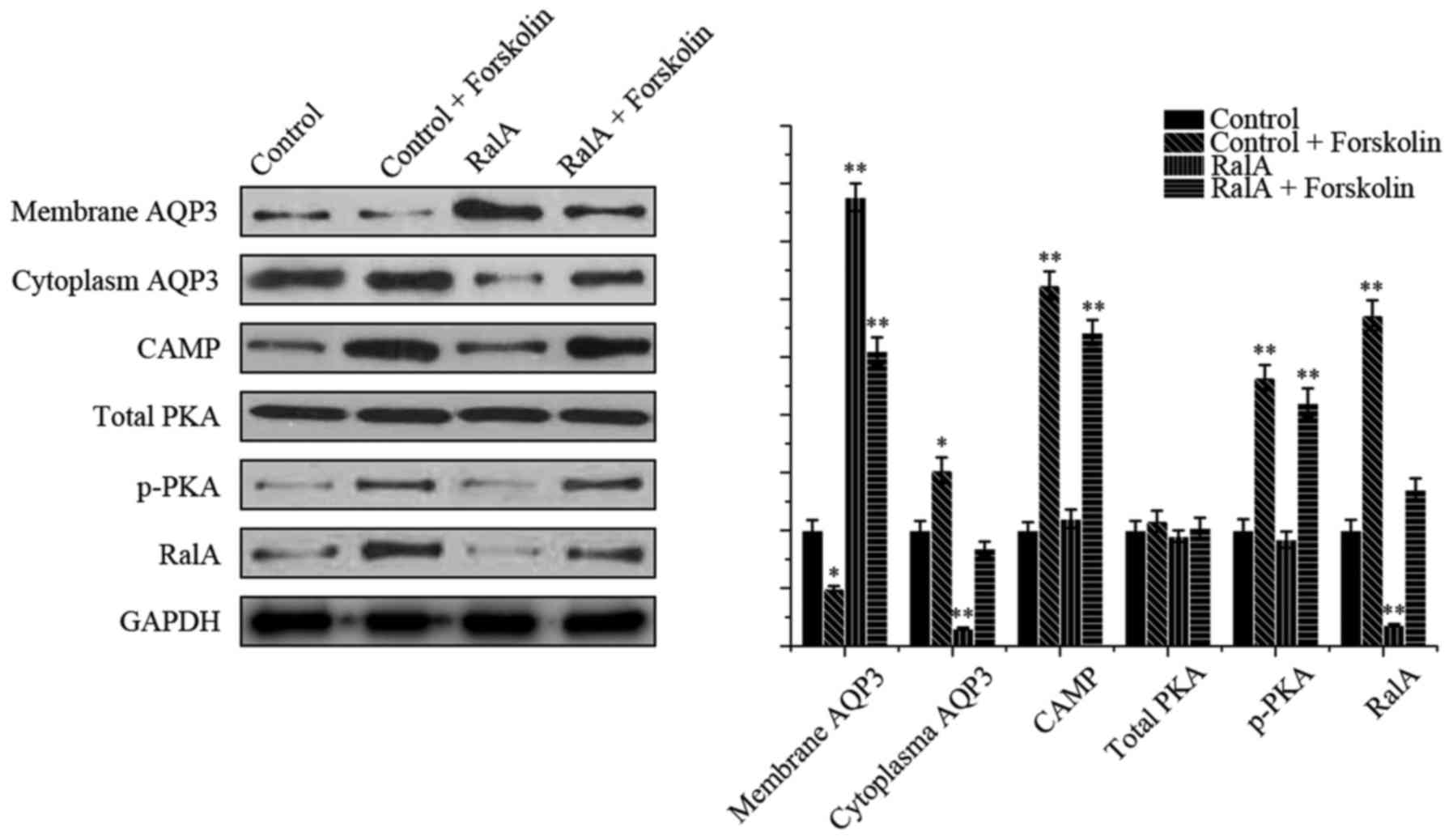Subcellular localization of aquaporin 3 in prostate cancer is regulated by RalA
- Authors:
- Published online on: March 9, 2018 https://doi.org/10.3892/or.2018.6308
- Pages: 2171-2177
Abstract
Introduction
Prostate cancer (PCa) is the most frequent male malignancy and a leading cause of cancer-related death in many Western countries (1). Disease progression in the majority of patients with androgen-dependent prostate cancer can generally be controlled; however, patients with androgen-independent disease and a metastatic phenotype consistently present with a poor prognosis (2).
The molecular mechanisms that underlie the metastatic process and secondary foci specificity are poorly understood. Mainly studies have focused on proteins that function in normal epithelial cells to maintain intercellular adhesion (3). For example, E-cadherin plays an important role in cell-cell adhesion, and a decrease in E-cadherin is associated with cancer progression (4,5). A recent study demonstrated that AQP3, a member of the aquaporins, colocalizes with E-cadherin in the early stages of cell-cell contact formation (6). Aquaporins (AQP) belong to a family of water-transporting proteins, and allow water, glycerol and small solutes through the cell membrane (7). AQP0, 1, 2, 4, 5, 6 and 8 allow the permeation of water. In addition, AQP3, 7, 9 and 10 transport glycerol and small solutes (8).
Our previous study demonstrated that AQP3 protein is intensely expressed on the cell membranes in normal human prostate cells and tissues, whereas in prostate cancer AQP3 is localized mainly in the cytoplasm (9). Moreover, a recent study showed that after disrupting the exocyst complex, AQP3 distribution to E-cadherin-rich cell-cell contacts was impaired (6). The exocyst, a conserved hetero-octameric protein complex, is localized to lateral membranes and developing apical domains of epithelial cells. In epithelial cells, the exocyst is redistributed from the plasma to areas of cadherin adhesion, and serves to transport post-Golgi transport vesicles to adhesion sites (10). Exocyst distribution and activity are regulated by small GTPases (11). Two of these, Arf6 and Ral, are important promoters of tumor growth and progression (12–14). Among the Ral subfamily, RalA and RalB are highly related GTPases that communicate with parts of the exocyst (Sec5 and Exo84) in vitro (13).
In the present study we explored the function of RAS like proto-oncogene A (RalA) in regulating the localization of AQP3 in androgen-independent prostate cancer. We found that depletion of RalA led to the redistribution of AQP3 into the plasma membrane. The tumor-promoting function of RalA in prostate cancer is possibly mediated by the cAMP signaling pathway in prostate cancer.
Materials and methods
Cell culture and reagents
Human prostate cancer cell line PC-3 was obtained from The American Type Culture Collection (ATCC; Manassas, VA, USA, USA). In this study, we used cells in fewer than 6 months after resuscitation. PC-3 was maintained as monolayer cultures in Gibco F-12 medium (Thermo Fisher Scientific, Inc., Waltham, MA, USA) with 10% fetal bovine serum (FBS), and incubated at 37°C with 5% CO2 in a humidified atmosphere.
Lentivirus infection
Lentivirus particles carrying shRNA (5′-GATCCGACAGGTTTCTGTAGAAGATTCAAGAGATCTTCTACAGAAACCTGTCTTTTT-3′) against RalA or scrambled shRNA (5′-GATCCTTCTCCGAACGTGTCACGTTTCAAGAGAACGTGACACGTTCGGAGAATTTTT-3′) (Santa Cruz Biotechnology, Santa Cruz, CA, USA) which has no interference with other cellular mRNA in PC-3 cells were constructed. According to the manufacturer's instructions (Santa Cruz Biotechnology) cells were treated. All functional assays were performed after cell infection.
For DNA transfection, PC-3 cells were grown to 75–80% confluence and then according to the manufacturer's instructions were transfected with a total of 2 mg of DNA (Life Technologies, Inc., Gaithersburg, MD, USA). E-cadherin expression vector and the neomycin resistance selection marker (Invitrogen; Thermo Fisher Scientific, Inc.) at a ratio of 20:1 were performed. Selective transfectants were tested for transgene expression.
Western blot analysis
For western blot analysis, in brief, protein was extracted using RIPA lysis buffer and protease inhibitor (Thermo Fisher Scientific, Inc.). Thirty micrograms of protein from each sample were separated on 10% SDS-polyacrylamide gel. GAPDH served as a loading control. Antibodies used included: AQP3 (1:200; rabbit polyclonal antibody; cat. no. ab125219) RalA (1:1,000; rabbit monoclonal antibody; cat. no. ab126627), E-cadherin (1:5,000; rabbit polyclonal antibody; cat. no. ab40772), cAMP (1:30,000; rabbit polyclonal antibody; cat. no. ab76238), T-PKA (1:2,000; rabbit polyclonal antibody; cat. no. ab38949), p-PKA (1:2,500; rabbit monoclonal; cat. no. ab75991) and GAPDH (1:10,000; mouse monoclonal antibody; cat. no. ab8245; all from Abcam, Cambridge, MA, USA).
Cell proliferation assays
For the clonogenic assay, cells were seeded onto 60-mm culture dishes at the density of 1,000 cells/well. After colonies formed (~10 days), the colonies were fixed, stained (crystal violet; cat no. KGA229; Nanjing KeyGen Biotech, Co., Ltd., Nanjing, China) and were counted [colonies with more than 50 cells were counted under a microscope at ×200 magnification (Leica microscope DM4000 B; Leica Microsystems, Wetzlar, Germany)].
For the proliferation assay, cells were seeded onto 96-well plates (5,000 per well) in F-12 with 5% FBS, and cells were treated according to the manufacturer's instructions (Keygentec, Taoshan, China). Absorbance was measured at 550 nm using Mikrotek Laborsysteme (Mikrotek, Overath, Germany).
In regards to the MTS assay, the cells were analyzed using a CellTiter 96® AQueous One Solution Cell Proliferation Assay Kit (Promega, Madison, WI, USA) at 490 mm absorbance according to the manufacturer's instructions. Doubling times were determined from four replicate samples per point.
Cell cycle distribution assay
Cells were harvested at 48 h and labeled with propidium iodide (PI) using previously described methods (15). Briefly, cells were resuspended and fixed, and then PI (0.05 mg/ml; Sigma-Aldrich; Merck KGaA, Darmstadt, Germany) was added to the cells and maintained at room temperature in the dark for 30 min. Cell cycle distribution was examined using a FACScan instrument equipped with FACStation running CellQuest software (Becton Dickinson, San Jose, CA, USA).
Cell apoptosis assay
Apoptosis was assessed by DNA ladder formation, double stained with Annexin V-fluorescein isothiocyanate (FITC)/PI and TUNEL assay. For DNA ladder formation assays, tumor cells were plated in 6-well plates and attached, and then washed twice with PBS, followed by treatment according to the manufacturer's instructions (KGA111; Nanjing KeyGen Biotech Co., Ltd.). A NanoDrop spectrophotometer (Thermo Fisher Scientific) was used to measure DNA concentrations. Total genomic DNA (5 µg) was separated on a 1% agarose gel and photographed with a VersaDoc molecular imager (Bio-Rad Laboratories, Hercules, CA, USA).
For FACS, with or without infection for 48 h, cells were collected and then double-stained with Annexin V-FITC and PI (Becton Dickinson). Cells were examined by a FACScan instrument equipped with FACStation running CellQuest software (Becton Dickinson).
A TUNEL assay was conducted to detect apoptosis
The samples were treated with 20 µg/ml non-deoxyribonuclease (DNase) proteinase K (Merck Drugs & Biotechnology Inc., Darmstadt, Germany) for 30 min at 37°C to remove the nuclease, followed by washing with PBS three times for 4 min each. Terminal deoxynucleotidyl transferase (TdT) (F. Hoffmann-La Roche & Co., Pleasanton, CA, USA) and biotin-dUTP (F. Hoffmann-La Roche & Co) were added to the samples, and the mixtures were incubated in the dark at 37°C for 60 min, followed by PBS washing. Labeling reaction termination solution was added to the samples, followed by incubation at 37°C for 60 min and washing with PBS. Streptavidin-HRP enzyme (F. Hoffmann-La Roche & Co.) (10 µl) and Biotin-dUTP (490 µl) were mixed and added onto the sections, and the sections were incubated in the dark for 60 min at 37°C. After PBS washing, 3-diaminobenzidine (DAB) solution (F. Hoffmann-La Roche & Co.) was used to develop the stain. The samples were counterstained with hematoxylin (Solarbio Science & Technology Co., Ltd., Beijing, China). The samples were washed with PBS, dehydrated, mounted in neutral resins and photographed (fluorescence microscope Leica TCS SP8; Leica Microsystems).
Wounding healing and invasion assays
Invasion assays were performed in 24-well BD BioCoat™ Matrigel Invasion Chambers (BD Biosciences, San Jose, CA, USA). After incubation, non-invading cells were removed and the bottom cells were stained with 0.2% crystal violet, and the stained cells were counted under a microscope (Leica microscope DM4000 B; Leica Microsystems) at ×200 magnification, and a bar graph was used to demonstrate the results.
Wound healing assay was performed after transfection as previously described (16). Images of the wound area were captured (Leica microscope DM4000 B; Leica Microsystems) at 0, 24 and 36 h.
Immunofluorescence microscopy
Cells were fixed in 4% paraformaldehyde, and permeabilized using 0.5% Triton X-100 in PBS and blocked, and then incubated with primary antibody AQP3 (1:250; rabbit polyclonal antibody; cat. no. ab125219; Abcam) and then stained with the secondary antibodies (Rhodamine-labelled secondary antibodies; cat. no. R-6394; Invitrogen; Thermo Fisher Scientific, Inc.). Nuclei were counterstained with DAPI (41,6-diamidino-2-phenylindole). Images were captured on a Leica TCS-SP8 fluorescence microscope (Leica Microsystems).
Statistical analysis and gene set enrichment analysis (GSEA)
All data are shown as the mean ± SD. Statistical analysis was performed with SPSS 17.0 (IBM, Armonk, NY, USA) and OriginPro 8.0 (Originlab, Northampton, MA, USA). Differences in mean values between two groups were analyzed by two-tailed Student's t-test and the mean values of more than two groups were compared with one-way analysis of variance (ANOVA). A P-value <0.05 was considered to indicate a statistically significant result. The prostate cancer dataset was downloaded from the NCBI Gene Expression Omnibus database, access ID: GSE55945).
Results
Downregulation of expression is correlated with the subcellular localization of AQP3 in PC-3 cells
According to the GEO dataset (Access ID: GSE55945), we found an increase in expression levels of RalA in prostate cancer tissues compared with level in the adjacent tissues of patients (Fig. 1, P<0.01). This result suggests a relationship between RalA mRNA expression and prostate cancer progression.
To further explore this phenomenon, PC-3 cell derivatives with stable knockdown of RalA were established. Moreover, according to Nejsum and Nelson (6), we established PC-3 cell derivatives with stable overexpression of E-cadherin as a positive control.
As shown in Fig. 2A, immunoblot analysis for total AQP3 in the three groups demonstrated that RalA knockdown and E-cadherin overexpression played no significantly role in regulating the total protein level of AQP3. Subcellular fractionation followed by immunoblot analysis showed the AQP3 band in PC-3 cell plasma and intracellular membranes. RalA knockdown and E-cadherin overexpression resulted in an increase in AQP3 in the PC-3 cell membrane and a simultaneous decrease in AQP3 in the plasma. Moreover, confocal immunofluorescence microscopy in PC-3 cells was in agreement with the quantitative immune blot analysis (Fig. 2B). These data suggest that RalA knockdown regulates the subcellular location of AQP3.
Silencing of RalA inhibits the proliferation of prostate cancer cells
After knockdown of RalA, the number of tumor cells was significantly less and smaller sizes of cell colonies formed were noted when compared with the control group (Fig. 3A, P<0.01), Moreover, according to the MTT and MTS assays, in the absence of RalA, the cell growth rate was significantly suppressed when compared with corresponding control (Fig. 3B, left and right graphs, P<0.01).
Knockdown of RalA enhances the apoptosis of prostate cancer cells
We next aimed to explore how RalA affects cell cycle progression. Flow cytometric analysis revealed that the percentage of PC-3 cells in the G0/G1 phase with viral transfection was markedly increased by 21.2% (Fig. 4A, P<0.05), and the percentage of S phase cells was significantly decreased, compared with the control cells. These results indicated that RalA enhanced G1/S cell cycle transition in prostate cancer cells.
We further determined the apoptotic rate after knockdown of RalA in the PC-3 cells by Annexin V-FITC/PI staining assay. As shown in Fig. 4B, flow cytometric analysis revealed that the silencing of RalA and overexpression of E-cadherin in PC-3 cells markedly enhanced cell death compared with that noted in the control group (RalA, 22.5±1.31% vs. E-cadherin, 17.9±1.26% vs. control, 3.2±0.33%; P<0.01).
In the TUNEL assay, we showed that AQP3 redistribution significantly induced cell apoptosis compared with the control (Fig. 4C; RalA, 78.9±4.5 cells/field vs. E-cadherin, 59.7±3.8 cells/field vs. control, 9.2±1.7 cells/field; P< 0.01).
Moreover, in the DNA Ladder assay, the treatment groups formed a ladder-like trend which suggested that AQP3 redistribution in PC-3 cells markedly enhanced cell death compared with that noted in the control group (Fig. 4D).
Silencing of RalA suppresses the migration and invasion of prostate cancer cells
We then investigated the function of RalA in the migration and invasion in the treated tumor cells. To this end, we conducted wound-healing and Transwell chamber assays. The results showed that RalA knockdown decreased the motility of tumor cells (Fig. 5A). Furthermore, the RalA knockdown group showed suppressed invasion in the Matrigel-coated Transwells when compared with the control group (Fig. 5B).
Ral GTPases stimulate GTP exchange on two substrates, RalA and RalB (17). Moreover, Shipitsin et al indicated that RalA enhances the delivery of vesicles containing E-cadherin between the trans-Golgi and the basolateral plasma membrane (18). In addition, Nejsum and Nelson concluded that basolateral membrane AQP3 is localized directly to initial areas of E-cadherin-mediated cell-cell adhesion (6). Therefore, we investigated that the presence of RalA components has an important effect on AQP3. To further explore the mechanism by which the signaling pathway is involved in regulating AQP3 via RalA, we focused on the PKA-cAMP signaling pathway which was found to regulate AQP8 subcellular location in rat hepatocytes (19).
Forskolin, a direct activator of adenylyl cyclases, was added to test the signaling pathway, The localization of AQP3 and the expression of pathway-associated protein were evaluated by western blot analysis (Fig. 6). As expected, the presence of forskolin (10 µM) resulted in less membranous and more cytoplasmatic distribution of AQP3 in the PC-3 cells, compared with the control group. In the shRNA-RalA group, treatment with forskolin redistributed AQP3. In addition, both p-PKA and RalA levels were increased compared with the control group, which indicated that a cAMP-PKA dependent pathway activated RalA and promoted AQP3 distribution.
Discussion
To the best of our knowledge, this is the first study on the subcellular location of AQP3 protein in prostate cancer cells. Our data suggest that AQP3 is localized largely in the cytoplasm and can be targeted to the plasma membrane in prostate cancer cells via a cAMP/PKA/RalA pathway.
Aquaporins play an important role in transporting water and small solutes. To date, 13 subtypes (AQP0-AQP12) have been detected in mammals (7,8). Expression of AQPs promotes disease progression and can predict the poor survival of cancer (8). Increased levels of AQP3 have been detected in squamous cell carcinoma of the skin, pulmonary adenocarcinoma, gastric cancer and colorectal adenocarcinoma (20–23). However, few studies have focused on the subcellular location change of AQP3 between normal prostate tissues and prostate cancer.
Nejsum and Nelson demonstrated that AQP3 targets directly to E-cadherin-mediated cell-cell contacts (6). Moreover, active RalA enhances the rate of delivery of E-cadherin (18). Therefore, we focused our efforts on investigating RalA in prostate cancer.
Ras-like (Ral) GTPases include RalA and RalB, which both have differential functions (24). In several types of cancers, increased expression of RalA has been identified (25–27). Consistent with these studies, according to the GEO dataset (Access ID: GSE45016), we found increased expression levels of RalA in prostate cancer tissues. Moreover, when we silenced RalA in PC-3 cells, we found that the intracellular AQP3 was re-localized to the cell membrane, thereby confirming our hypothesis. In addition, we knocked down RalA in PC-3 cells and found significantly reduced colony formation and cell proliferation, as well as suppression of G1/S cell cycle phase cells and enhanced cell apoptosis. This was consistent with a study by Ismail et al who found that cryotherapy also redistributed the localization of AQP3 and enhanced the sensitivity of prostate cancer cells to cryotherapy treatment (28). In addition, RalA knockdown suppressed migration and invasion of tumor cells.
The mechanism underlying the regulation of AQP3 subcellular location in prostate cancer remains unclear. We suggest that localization of AQP3 expression was regulated by the cAMP/PKA/RalA signaling pathway. This signaling pathway has been considered as a regulator of cellular migration, invasion and metastasis (29,30). Our data showed that enhanced adenylyl cyclases activation increased RalA expression in shRNA-RalA cells, indicating an important role for the cAMP-PKA-RalA pathway in regulating AQP3 subcellular location.
In summary, we found that RalA was overexpressed in prostate cancer and plays an important role in regulating localization of AQP3 expression and further enhances the proliferation, apoptosis and metastasis of prostate cancer cells. The localization of AQP3 expression may be regulate by these biological processes through the cAMP/PKA/RalA signaling pathway. These data provide evidence for targeted therapy.
Acknowledgements
This study was supported by grants from the National Natural Science Foundation of China (nos. 81372761 and 31570953).
References
|
Siegel R, Naishadham D and Jemal A: Cancer statistics, 2013. CA Cancer J Clin. 63:11–30. 2013. View Article : Google Scholar : PubMed/NCBI | |
|
Ruscetti M, Quach B, Dadashian EL, Mulholland DJ and Wu H: Tracking and functional characterization of epithelial-mesenchymal transition and mesenchymal tumor cells during prostate cancer metastasis. Cancer Res. 75:2749–2759. 2015. View Article : Google Scholar : PubMed/NCBI | |
|
Egan A, Dong Y, Zhang H, Qi Y, Balk SP and Sartor O: Castration-resistant prostate cancer: Adaptive responses in the androgen axis. Cancer Treat Rev. 40:426–433. 2014. View Article : Google Scholar : PubMed/NCBI | |
|
Wu YC, Tang SJ, Sun GH and Sun KH: CXCR7 mediates TGFβ1-promoted EMT and tumor-initiating features in lung cancer. Oncogene. 35:2123–2132. 2016. View Article : Google Scholar : PubMed/NCBI | |
|
An HT, Yoo S and Ko J: α-Actinin-4 induces the epithelial-to-mesenchymal transition and tumorigenesis via regulation of Snail expression and beta-catenin stabilization in cervical cancer. Oncogene. 35:5893–5904. 2016. View Article : Google Scholar : PubMed/NCBI | |
|
Nejsum LN and Nelson WJ: A molecular mechanism directly linking E-cadherin adhesion to initiation of epithelial cell surface polarity. J Cell Biol. 178:323–335. 2007. View Article : Google Scholar : PubMed/NCBI | |
|
Papadopoulos MC and Saadoun S: Key roles of aquaporins in tumor biology. Biochim Biophys Acta. 1848:2576–2583. 2015. View Article : Google Scholar : PubMed/NCBI | |
|
Ribatti D, Ranieri G, Annese T and Nico B: Aquaporins in cancer. Biochim Biophys Acta. 1840:1550–1553. 2014. View Article : Google Scholar : PubMed/NCBI | |
|
Wang J, Tanji N, Kikugawa T, Shudou M, Song X and Yokoyama M: Expression of aquaporin 3 in the human prostate. Int J Urol. 14:1088–1092. 2007. View Article : Google Scholar : PubMed/NCBI | |
|
Yeaman C, Grindstaff KK and Nelson WJ: Mechanism of recruiting Sec6/8 (exocyst) complex to the apical junctional complex during polarization of epithelial cells. J Cell Sci. 117:559–570. 2004. View Article : Google Scholar : PubMed/NCBI | |
|
Prigent M, Dubois T, Raposo G, Derrien V, Tenza D, Rossé C, Camonis J and Chavrier P: ARF6 controls post-endocytic recycling through its downstream exocyst complex effector. J Cell Biol. 163:1111–1121. 2003. View Article : Google Scholar : PubMed/NCBI | |
|
Chabu C, Li DM and Xu T: EGFR/ARF6 regulation of Hh signalling stimulates oncogenic Ras tumour overgrowth. Nat Commun. 8:146882017. View Article : Google Scholar : PubMed/NCBI | |
|
Pawar A, Meier JA, Dasgupta A, Diwanji N, Deshpande N, Saxena K, Buwa N, Inchanalkar S, Schwartz MA and Balasubramanian N: Ral-Arf6 crosstalk regulates Ral dependent exocyst trafficking and anchorage independent growth signalling. Cell Signal. 28:1225–1236. 2016. View Article : Google Scholar : PubMed/NCBI | |
|
Gentry LR, Nishimura A, Cox AD, Martin TD, Tsygankov D, Nishida M, Elston TC and Der CJ: Divergent roles of CAAX motif-signaled posttranslational modifications in the regulation and subcellular localization of Ral GTPases. J Biol Chem. 290:22851–22861. 2015. View Article : Google Scholar : PubMed/NCBI | |
|
Henry MK, Lynch JT, Eapen AK and Quelle FW: DNA damage-induced cell-cycle arrest of hematopoietic cells is overridden by activation of the PI-3 kinase/Akt signaling pathway. Blood. 98:834–841. 2001. View Article : Google Scholar : PubMed/NCBI | |
|
Chen Q, Yang D, Zong H, Zhu L, Wang L, Wang X, Zhu X, Song X and Wang J: Growth-induced stress enhances epithelial-mesenchymal transition induced by IL-6 in clear cell renal cell carcinoma via the Akt/GSK-3β/β-catenin signaling pathway. Oncogenesis. 6:e3752017. View Article : Google Scholar : PubMed/NCBI | |
|
Thomas JC, Cooper JM, Clayton NS, Wang C, White MA, Abell C, Owen D and Mott HR: Inhibition of Ral GTPases using a stapled peptide approach. J Biol Chem. 291:18310–18325. 2016. View Article : Google Scholar : PubMed/NCBI | |
|
Shipitsin M and Feig LA: RalA but not RalB enhances polarized delivery of membrane proteins to the basolateral surface of epithelial cells. Mol Cell Biol. 24:5746–5756. 2004. View Article : Google Scholar : PubMed/NCBI | |
|
García F, Kierbel A, Larocca MC, Gradilone SA, Splinter P, LaRusso NF and Marinelli RA: The water channel aquaporin-8 is mainly intracellular in rat hepatocytes, and its plasma membrane insertion is stimulated by cyclic AMP. J Biol Chem. 276:12147–12152. 2001. View Article : Google Scholar : PubMed/NCBI | |
|
Hua Y, Ma X, Liu X, Yuan X, Qin H and Zhang X: Identification of the potential biomarkers for the metastasis of rectal adenocarcinoma. APMIS. 125:93–100. 2017. View Article : Google Scholar : PubMed/NCBI | |
|
Xia H, Ma YF, Yu CH, Li YJ, Tang J, Li JB, Zhao YN and Liu Y: Aquaporin 3 knockdown suppresses tumour growth and angiogenesis in experimental non-small cell lung cancer. Exp Physiol. 99:974–984. 2014. View Article : Google Scholar : PubMed/NCBI | |
|
Chen J, Wang T, Zhou YC, Gao F, Zhang ZH, Xu H, Wang SL and Shen LZ: Aquaporin 3 promotes epithelial-mesenchymal transition in gastric cancer. J Exp Clin Cancer Res. 33:382014. View Article : Google Scholar : PubMed/NCBI | |
|
Ishimoto S, Wada K, Usami Y, Tanaka N, Aikawa T, Okura M, Nakajima A, Kogo M and Kamisaki Y: Differential expression of aquaporin 5 and aquaporin 3 in squamous cell carcinoma and adenoid cystic carcinoma. Int J Oncol. 41:67–75. 2012.PubMed/NCBI | |
|
Hobbs GA, Der CJ and Rossman KL: RAS isoforms and mutations in cancer at a glance. J Cell Sci. 129:1287–1292. 2016. View Article : Google Scholar : PubMed/NCBI | |
|
Padavano J, Henkhaus RS, Chen H, Skovan BA, Cui H and Ignatenko NA: Mutant K-RAS promotes invasion and metastasis in pancreatic cancer through GTPase signaling pathways. Cancer Growth Metastasis. 8 Suppl 1:S95–S113. 2015. | |
|
Győrffy B, Stelniec-Klotz I, Sigler C, Kasack K, Redmer T, Qian Y and Schäfer R: Effects of RAL signal transduction in KRAS- and BRAF-mutated cells and prognostic potential of the RAL signature in colorectal cancer. Oncotarget. 6:13334–13346. 2015. View Article : Google Scholar : PubMed/NCBI | |
|
Wang K, Terai K, Peng W, Rouyanian A, Liu J, Roby KF, Wise AL, Ezzeldin M, Larson J, Woo RA, et al: The role of RalA in biology and therapy of ovarian cancer. Oncotarget. 2013. | |
|
Ismail M, Bokaee S, Morgan R, Davies J, Harrington KJ and Pandha H: Inhibition of the aquaporin 3 water channel increases the sensitivity of prostate cancer cells to cryotherapy. Br J Cancer. 100:1889–1895. 2009. View Article : Google Scholar : PubMed/NCBI | |
|
Ezzeldin M, Borrego-Diaz E, Taha M, Esfandyari T, Wise AL, Peng W, Rouyanian A, Kermani Asvadi A, Soleimani M, Patrad E, et al: RalA signaling pathway as a therapeutic target in hepatocellular carcinoma (HCC). Mol Oncol. 8:1043–1053. 2014. View Article : Google Scholar : PubMed/NCBI | |
|
Yu T, Yang G, Hou Y, Tang X, Wu C, Wu XA, Guo L, Zhu Q, Luo H, Du YE, et al: Cytoplasmic GPER translocation in cancer-associated fibroblasts mediates cAMP/PKA/CREB/glycolytic axis to confer tumor cells with multidrug resistance. Oncogene. 36:2131–2145. 2017. View Article : Google Scholar : PubMed/NCBI |



